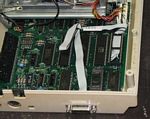Installing the 1571 Parallel Port Option
Parts needed:
Drill, bits and files to make & shape the hole in the 1571 chassis.
Introduction
The 1571 parallel port hooks up to the 6526 or 8521 CIA at position U20. This chip is typically socketed, so the socketed cable should work. All it requires is to remove the power supply, pop out the CIA chip, insert the socketed cable and re-insert the CIA. If the CIA is not socketed either install a socket for the chip or use the soldered cable and solder the port wires directly to the CIA chip (top or bottom of the board). I have yet to see a CIA chip in a 1571 that is not socketed but it is possible.
Warning: when the socketed cable is installed and the CIA is re-inserted into the socket, the corner of the power supply near the CIA chip will rest on the top of the CIA instead of on the riser post. You can glue/add about 1/16" (2 mm) of flat washers to the top of the riser post so the supply won't touch the chip or else don't tighten the screw too much on that corner because you could damage the board from the stress.
If the firmware on your 1571 is older (310654-03 or less) then you likely will have an issue with the drive taking a long time to access 1541 disks after they are inserted. The drive will act as though the head is out of alignment as it attempts to read it. Once they are recognized they will read fine. This issue is fixed with the later ROM version 310654-05 or with JiffyDOS.
I ran into many issues when modding my 1571 for parallel. The door latch pin was loose, the door handle stem was loose, the latch lowering mechanism wasn't pushing the spindle down far enough so the disk wouldn't turn, and the old ROM revision caused initial reading problems. However, when these issues are dealt with, the 1571 is a very fast drive on parallel, feeling about 20% faster than a 1541.
Step 1: Build the internal parallel cable
Click here for the instructions on how to build the internal parallel cable for your 1571 drive.
Step 2: Top case removal
Step 3: Power supply removal
Step 4: Shape a case hole & install cable
Step 5: Close everything up & test
 |
This is the completed parallel port installation. I like how the DB15 port is almost inline with the serial ports. |
Email the author: Peter Schepers | Last updated: Sept 8, 2009


